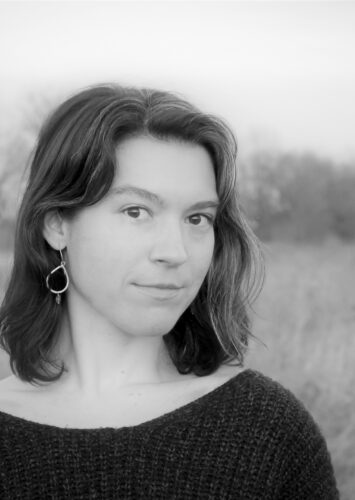Hannah Bonner’s strikingly precise debut, Another Woman, shifts feminine devotion inward, sharing a vulnerable practice of self-exploration on display through economized yet musical language. Bonner’s attentiveness to the line, fluid shifts in the natural landscapes that outline these poems, and vigilance in honoring those who share the title of “woman” gives us a generous and thoughtful collection that speaks to the current moment of womanhood and the cyclical nature of self-discovery.
There is a restraint here which Bonner employs regularly, including in the book’s dreamy, dark cover, where the blur and omission of Another Woman’s woman breeds curiosity. It is worth noting that not one piece in this collection moves beyond a page, which invites readers into the intimate and determined fate of as few as four lines. She blends naturalistic and personal narratives with her speaker’s thoughts, marrying the two to eloquently express heartache, lust, loss, and tentative acceptance. At several points, she accomplishes all of this in a single poem. In “Fireflies in July,” a nine-line poem, a scene of fireflies is described as “a surge of stars cellular through grasses, / erotic as the pulse of skin before skin,” which is interrupted by desperate longing with “Like you looking at me, / the whole night turns over” (22). Her speaker’s thoughts and their paired natural scenes together reflect contrasting shades of liability and tenacity.
The brevity of Bonner’s work clearly does not inhibit her speaker’s obtrusive, wild longing, which later opens to a more settled understanding of the self. While a romantic relationship takes some of the focus in this book, the main attraction is the quiet metamorphosis of the speaker. We start with a martyrish desire that informs behavior, like in “Inventory of Shimmers”: “Tell me to wait like a woman / anyone would recognize, / walking into the world with her palms open, / accepting nothing but the fire” (27). This idea carries for a while, reinforced by lines like “how delicate the thread // between tenderness and terror” and “Sometimes the sound we make / devours us” (28, 30).
The anger borne of heartache envelopes much of the next section, shaking the attitudes of the speaker awake in the changing seasons. In “Instructions for Finishing,” Bonner brandishes an erotic scene like a knife, hurt and angry, saying, “I won’t repair / your marriage I almost ruined. // I won’t hate myself more than necessary” (36). The fury and self-loathing that passes through this season prepares us for the wilting hurt that bleeds into resolve in the latter half of the book. This is where we become engrossed in Bonner’s stellar occupation with the natural, stripping scenes down to their barest branches. At “Still Life with Citrus in February,” we are tenderly rocked towards springtime, a time of building: “Relief across a blameless ground, / a bright light, // no longer begging” (55).
There is a linear aspect to this collection that reflects reality in that it is not perfectly linear. During this gift of spring, we get flashbacks to memories amidst a solid timeline (“I felt around in the dark / for you. The stars // like little notes we tack up / in order to survive”); we get regressions in the speaker’s emotional distance (“I carry a long-lost love pressed / deep within my skins”), a constant returning that mimics the cyclical pain of true heartbreak and finding oneself over and over (64, 66). While the final poem could be read as an ultimate regression, it can also be argued that it points to a swelling of self-love, “forever branching for, then through,” a meeting with one’s inner desires as for the first time (73). In Another Woman, Bonner gives us much to celebrate, mourn, and continually discover, as all poetry collections aspire to accomplish.
